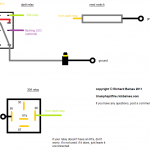21 AprThe ‘World’s Best’ DIY Immobiliser
Came across this article recently: http://www.autospeed.com/A_107975/cms/article.html
which basically outlines how to fit a hidden immobiliser in your car. Instead of the usual killswitch to the coil, this one has a killswitch but can only be reactivated by swiping a magnet over a hidden location – if the thief can only find your pushswitch, he or she still can’t start the car.
This little modification is great for our Triumphs as they came with very little in the way of anti-theft measures from the factory. The article is good at explaining how the switch works, but the schematic is poor for explaining how to wire it up, especially if you don’t do much electronics.
Consequently, I’ve made you a simplified diagram:
(click to view enlarged version)
Pins 30 and 87 are where your interrupted circuit goes in, for example if you were disabling the ignition coil with this, you would take the connector off the + side of the coil and connect it to 87. Then run a wire from 30 to the + side of the coil. The automotive relay is now taking your ignition coil in and out of the circuit depending on whether the immobiliser is on or not.
The main problem with diagrams is that depending on what relay you use for the lower powered DPDT relay, the pins might be wired slightly differently. I’ve drawn the diagram with this relay in mind, available from Maplin:

You want to order Maplin product # FJ43W, “12V 8A miniature relay“. It’s only £3.49 and was the most expensive part of the circuit. The ‘reed switch’ can be just one half of an alarm contact (99p on ebay), the other half can become the magnet used to reactivate the circuit. The push switches usually only cost around £1, and 30/40A automotive relays should cost under £2.
You can use an LED if you’d prefer a deterrent, or leave it off if you don’t want people to start looking for an immobiliser. The choice is yours.










The relay that Maplin are currently selling as a DPDT relay is product # N08AW and has a different pin orientation. Assuming that the pin numbering starts at the top and works down from L to R finishing with pin 8 in the bottom RH corner, it looks to me as if for your diagram to work, the switchable current must have been fed into the centre two pins of the switchable pair (pins 3 & 4). The one that I have bought has the feed to the switchable pair being fed into pins 5 & 6 which means that I need to adjust your diagram.
Could you please confirm that your relay was as I have assumed with the feed switchable feed into pins 3 & 4?
Thks Ian
Sorry for the slow reply Ian.
“Assuming that the pin numbering starts at the top and works down from L to R finishing with pin 8 in the bottom RH corner”
that’s what I assumed as well, and was wrong. This diagram is exactly how I ended up wiring the switch, as it was fed into 5&6 like yours.
Might be worth doing a trial run before soldering the connections permanently if you’re not sure….
Hello all, I would like to thank you for this post, its very helpful and useful to people like me. Appreciated it. I have few questions if I may ask:
1) I got this DPDT relay http://uk.farnell.com/finder/60-12-8-024-0040/relay-dpco-10a-24vac/dp/1169187 is it the correct one?
2) The coil in DPDT relay is on 2 and 7, but the diagram here shows 7 and 8, how it that possible?
3) Do I have to keep the magnet in contact with the reed switch all the time in order to keep the circuit up and running? Because the way I understand it is that, when I remove the magnet from the reed switch the circuit would die! Or am I missing something here.
Thank you all,
Yazen
Hi Yazen, hope this helps:
1) It’s not the relay I’d recommend using – it’s a 24v one, and cars use 12v.
2) Because it’s not the same relay. Different relays have different pin configurations, unfortunately there isn’t a standardised pin numbering system for DPDT relays.
3) I think you must have misunderstood the circuit. Funnily enough though, the way you describe it working is what I ended up with on my first test – I ended up having to reverse the pin layout, and that’s why I drew this diagram – so people would have a guaranteed way of it working with a specific part, in this case the one from Maplin.
regards
Richard
Hi Rick,
Thanks heaps for your prompt reply. Appreciate it.
1) Okay, i will get the same DPDT relay from Maplin, part #FJ43W
2) Now i understand 🙂
3) I still dont understand how the reed switch functions, when the reed switch is on the circuit is on, but as soon as you remove the magnet the reed switch will turn off which will turn the whole circuit off, isnt that correct? or the reed switch stays on after i remove the magnet? if the reed switch would turn off after you remove the magnet then how will the circuit remain on?
Thanks once again,
Yazen
The reed switch and the push button make this circuit work by each providing a possible way for the DPDT’s ground to be completed or broken. The ground for the DPDT relay is the pin on the right on the diagram, right at the bottom of the relay.
If this ground is floating (ie not connected), the relay has no power and won’t do anything. As soon as the ground is connected momentarily by pushing the button, it changes position. It doesn’t move back until you swipe the reed switch with a magnet, which if I remember rightly, momentarily interrupts the ground connection when swiped (as opposed to breaking it).
To be honest it’s a pretty confusing circuit, and even when I had it working I spent ages thinking about it to figure out how exactly it was working. I sortof knew then but even now I’m confusing myself thinking about it!
Richard
Thank you Rick, I will ty and constuct this device over the weekend and would share the pictures with you guys! lets hope i wont mess it up though 🙂
Thanks again,
Yazen
Rick I think in your diagram the two switches are the wrong way round, if the two top poles are connected to the two below them when the coil has power. If the pushbutton switch breaks the circuit when pushed, it means the relay coil will always be powered if the switches are as per your diagram, not?
Regards,
Nicki
Ordinarily I would say yes, but when I connected it like that, the circuit worked in the opposite way. I think the relay that Maplin supplies must work in the opposite way, so I just made up the diagram so it’d work for that particular part.
Thanks for the reply. I could not find a pinout for the Maplin relay anywhere, so I assumed the two top contacts would be NO. Maybe the two poles work opposite.
I’m going to be building one soon using this relay: http://www.fort777.co.za/index.php?main_page=product_info&cPath=269_270_425_427&products_id=5495